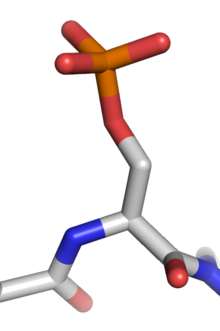

Protein phosphorylation is a reversible post-translational modification of proteins in which an amino acid residue is phosphorylated by a protein kinase by the addition of a covalently bound phosphate group. Phosphorylation alters the structural conformation of a protein, causing it to become activated, deactivated, or otherwise modifying its function.[1] Approximately 13,000 human proteins have sites that are phosphorylated.[2]
The reverse reaction of phosphorylation is called dephosphorylation, and is catalyzed by protein phosphatases. Protein kinases and phosphatases work independently and in a balance to regulate the function of proteins.[3]
The amino acids most commonly phosphorylated are serine, threonine, tyrosine, and histidine.[4][5] These phosphorylations play important and well-characterized roles in signaling pathways and metabolism. However, other amino acids can also be phosphorylated post-translationally, including arginine, lysine, aspartic acid, glutamic acid and cysteine, and these phosphorylated amino acids have been identified to be present in human cell extracts and fixed human cells using a combination of antibody-based analysis (for pHis) and mass spectrometry (for all other amino acids).[5][6][7][8]
Protein phosphorylation was first reported in 1906 by Phoebus Levene at the Rockefeller Institute for Medical Research with the discovery of phosphorylated vitellin.[9] However, it was nearly 50 years until the enzymatic phosphorylation of proteins by protein kinases was discovered.[10]
- ^ Cohen, Philip (2002-05-01). "The origins of protein phosphorylation". Nature Cell Biology. 4 (5): E127–130. doi:10.1038/ncb0502-e127. ISSN 1465-7392. PMID 11988757. S2CID 29601670.
- ^ Cite error: The named reference
:0was invoked but never defined (see the help page). - ^ Ilan Smoly, Netta Shemesh, Michal Ziv-Ukelson, Anat Ben-Zvi, Esti Yeger-Lotem (January 2017). "An Asymmetrically Balanced Organization of Kinases versus Phosphatases across Eukaryotes Determines Their Distinct Impacts". PLOS Computational Biology. 13 (1): e1005221. Bibcode:2017PLSCB..13E5221S. doi:10.1371/journal.pcbi.1005221. PMC 5279721. PMID 28135269.
{{cite journal}}: CS1 maint: multiple names: authors list (link) - ^ Potel, Clement M.; Lin, Miao-Hsia; Heck, Albert J. R.; Lemeer, Simone (March 2018). "Widespread bacterial protein histidine phosphorylation revealed by mass spectrometry-based proteomics". Nature Methods. 15 (3): 187–190. doi:10.1038/nmeth.4580. hdl:1874/362159. ISSN 1548-7105. PMID 29377012. S2CID 3367416.
- ^ a b Fuhs SR, Meisenhelder J, Aslanian A, Ma L, Zagorska A, Stankova M, Binnie A, Al-Obeidi F, Mauger J, Lemke G, Yates JR 3rd, Hunter T (2015). "Monoclonal 1- and 3-Phosphohistidine Antibodies: New Tools to Study Histidine Phosphorylation". Cell. 162 (1): 198–210. doi:10.1016/j.cell.2015.05.046. PMC 4491144. PMID 26140597.
- ^ Hardman G, Perkins S, Brownridge PJ, Clarke CJ, Byrne DP, Campbell AE, Kalyuzhnyy A, Myall A, Eyers PA, Jones AR, Eyers CE (2019). "Strong anion exchange-mediated phosphoproteomics reveals extensive human non-canonical phosphorylation". EMBO J. 38 (21): e100847. doi:10.15252/embj.2018100847. PMC 6826212. PMID 31433507.
- ^ Fuhs SR, Hunter T (2017). "pHisphorylation: the emergence of histidine phosphorylation as a reversible regulatory modification". Curr Opin Cell Biol. 45: 8–16. doi:10.1016/j.ceb.2016.12.010. PMC 5482761. PMID 28129587.
- ^ Cieśla J; Frączyk T; Rode W (2011). "Phosphorylation of basic amino acid residues in proteins: important but easily missed" (PDF). Acta Biochimica Polonica. 58 (2): 137–147. doi:10.18388/abp.2011_2258. PMID 21623415.
- ^ Levene PA; Alsberg CL (1906). "The cleavage products of vitellin". J. Biol. Chem. 2 (1): 127–133. doi:10.1016/S0021-9258(17)46054-6.
- ^ Burnett G; Kennedy EP (December 1954). "The enzymatic phosphorylation of proteins". J. Biol. Chem. 211 (2): 969–80. doi:10.1016/S0021-9258(18)71184-8. PMID 13221602.
© MMXXIII Rich X Search. We shall prevail. All rights reserved. Rich X Search
